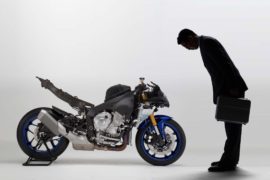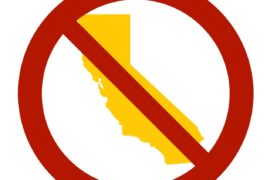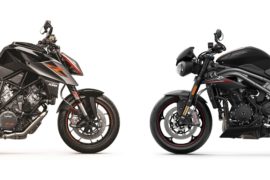Talking to Asphalt & Rubber at the launch of the Ducati 1299 Panigale Final Edition, Ducati CEO Claudio Domenicali gave us some details on the Italian company’s upcoming, and long-awaited, V4 superbike.
Much has already been speculated and rumored about the successor to the v-twin Panigale, but Domenicali paints a pretty clear picture of what we can expect to see unveiled at the upcoming EICMA show, in Milan.
The big news is perhaps not the fact that Ducati is moving to a four-cylinder format for its superbike program (though that is big news indeed), but instead the focus should be on what is inside the V4 engine, and how it operates.
Talking during the WorldSBK weekend at Laguna Seca, he also teased us with some news on a few other upcoming Ducati motorcycles, which should start a new chapter for the Italian brand.
Because Two Is Greater Than Four
For Ducatisti, there is no bigger news item than Ducati’s departure from the v-twin platform for its apex motorcycle. Though the Italian brand started with single-cylinder machines, it is known best for its desmodromic, 90°, v-twin engines, which permeates throughout the entire line.
Moving from the twin-cylinder format to the four-cylinder format hasn’t been an easy choice for Ducati, but the brand has been racing a V4 in the MotoGP Championship since it began racing that series, so there is a strong precedent for the move, along with a good technological motivation to do so.
“This is the last edition, because we wanted to move onto the V4,” said Domenicali curtly. “So, the question is then why move to a V4? Actually, we made a ten-year experience in MotoGP, and we thought it was a pity that all we have learned in this time period, not to make that available to our customers.”
“We do not consider it that companies should stay still for long periods of time,” he continued. “But, sometimes companies use some kind of technological solution as a flag, only because they are not able to think of something different.”
“So we did not think it was something wrong to continue changing it and improving it [the v-twin platform]. This engine is a superb engine, and there are some characteristics that still remain unmatched. But on the other hand, the balance between weight, power, and torque of the V4 we are developing is superior.”
Addressing the concerns of Ducatisti, that Ducati is tied to a twin-cylinder, Domenicali had an interesting response. “I think that one option would be to try the engine, the new engine, and then to make a judgment. In my opinion, that would be the best idea.”
“Of course, it is possible that there will be some people that will continue to prefer some of the characters of the twin, and this is why we have the Final Edition, because they can even buy it next year, it’s actually not an ending series.”
“But, we think that it will be a small group of people, because we have taken care in the development of the [V4] bike and the development of the engine, to fill in a lot of Ducati character.”
“How is the torque? How is the sound? How is the vibration? So we are not worried about that. The bike is a very good bike.”
Big Bang Firing Order
Domenicali is confident that Ducati owners, and in fact all motorcycle enthusiasts will be intrigued by Ducati’s new V4 superbike, namely because of the technology that resides inside its crankcases.
If the Panigale was an exhibition of the kind of outside-of-the-box thinking that the Italian brand can bring to chassis design – cue the company’s “frameless” chassis design – the still unnamed V4 superbike will showcase what Ducati’s engineers can do when it comes to designing an engine.
Based off Ducati’s MotoGP program, specifically the Ducati Desmosedici GP15, we can already guess at a unique “big bang” firing order. Domenicali confirms as much, without saying so.
“We have some tricks in the engine, that are very interesting. And when you couple this engine, a short-stroke, multiple-cylinder, with a desmodromic valves, you come out with a combination that is something which is unique.”
“It will make it different from any other four-cylinder on the market. This is the reason why our engine in MotoGP is so special, because it’s the only desmo engine.”
When asked directly if the V4 had a “big bang” firing order, Domenicali would only reply by saying that “it’s something very unique,” and that the engine would mimic the character of its v-twin predecessor. However, we know from Ducati’s program that the Italian brand runs a big-bang-like firing order.
Connecting the dots, the V4 production bike could fire two cylinders at a time, effectively making it a four-cylinder twin (if that makes logical sense to say), or it could have a firing order that is a bit more spaced out, but still retains a big bang firing character – which is rumored to be the case with Ducati’s MotoGP race bike.
Domenicali hints at this while talking about the company’s racing program, and how it has lead to the development of the V4 street bike platform.
“I think racing is relevant, but more than that, the whole experience and technical development that has gone into this engine – the fact that MotoGP has this configuration means that there has been many, many years of development for this engine. So that means we can put a lot of small stuff on the [production] engine.”
“And actually, the desmo system is far more relevant on a higher revving engine – let’s say high-revs, but not so high like our current v-twin – so when you sum them up everything, and when you consider that we have a special firing order on our V4, it makes it something between a v-twin and V4.”
“The most interesting stuff is inside,” Claudio Domenicali concluded, with a smile.
Other V4 Models
The most interesting word to come out of the CEO’s mouth though was that the V4 engine would be a platform engine, meaning that it would exist in other models, in different motorcycle segments.
“The V4 will be a platform, and it will be on different kinds of bikes,” Domenicali told us, while talking about the future of the Italian brand. What those models are, he could not say. “I could tell you, but then I’d have to kill,” he said…possibly in earnest.
But, one doesn’t have to think too had about which models in Ducati’s lineup could benefit from a high-tech V4 engine, one between 1,000cc and 1,200cc in engine displacement.
Talking that same evening to Rennie Scaysbrook at Cycle News, Domenicali wouldn’t confirm the rumors that the V4 superbike would come in two displacements, as had been rumored.
And while it may be the case the the V4 superbike will come in multiple displacements, another possibility for those rumors existence is that a 1,200cc version of the V4 engine could be destined for bikes like the Multistrada 1200, XDiavel, etc.
A 600cc V4 Supersport?
With Ducati seemingly back into sync with its model displacement, in relations to WorldSBK rules and what other manufacturers produce, our next thought was whether there was a future for a smaller V4 engine, say for a 600cc supersport machine.
In the most honest answer I’ve ever seen from a motorcycle exhaust, Domenicali dashed our hopes, simply saying “uhh…no.” With our dreams dashed, spirits crestfallen, futures collided, Domenicali had a compelling argument for this decision, however.
“The [V4] engine is an expensive, because of how it’s built inside. You would never strip it down to this level of price, that you need to be to be in this class,” Domenicali said, while talking of the 600cc supersport category.
“You cannot be in this class, and ask for 80% higher in price. You can ask for a premium, but can’t ask for double,” he finished by saying.
The Future for Superquadro
While there may not be a racing supersport in the company’s future, Ducati has a long history of repurposing its superbike engine designs for more tame street models, and so with the new V4 coming, we wondered about where that leaves the Superquadro engine design.
It’s here where the Ducati CEO gave us a surprise, suggesting that the Superquadro motor may not see life beyond its superbike application.
“We will have the smaller version [of the Superquadro], the 959, that will continue to be developed. So we will continue to have a middleweight superbike, twin-cylinder, that will be continuously updated.”
“So, in the just-below one-liter class, we will continue to have a very nice, something like 160 horsepower, engine. It will be a very good compromise between horsepower, drivability, road use ability, and thus we think it’s a good application for the twin.”
But when it comes to using the 959 Superquadro engine outside of the Ducati 959 Panigale, Domenicali was clear. “That’s not the plan. We have a very nice 937cc engine, which is working pretty well. It’s a very good platform, so we will continue to use that platform as well. And so, we are developing the platform.”
When asked if the Testastretta engine would continue to be the engine of choice for new models (fingers crossed for a new Streetfighter model), Domenicali replied in the affirmative, though again would not give details on what those machines could be.
The Long Goodbye
Ducati’s thought process for the future seems to be of two minds. With the backbone of the brand, the street bike line, continuing to use and develop on the same v-twin engine platform, while a new, high-performance line will benefit from the features of Ducati’s new V4 production engine.
Where that takes Ducati could be an intriguing road. With rumors of Ducati’s sale to another brand, like Harley-Davidson, continuing to swirl, the future for Ducati shall be interesting – in the Chinese proverb sense of the world.




